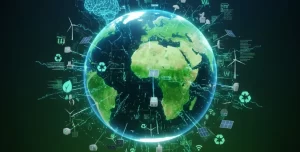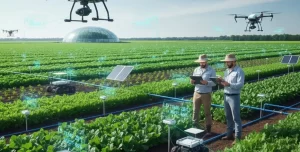
What is Green Technology and How AI is Making it Smarter?
Table of Contents
Introduction
Welcome to WikiGlitz! Integrating artificial intelligence (AI) with green technology is paving the way for smarter, more efficient solutions. In this blog, we’ll explore what green technology is, its significance, and how AI is revolutionizing this field to create a sustainable future.
Key Takeaways
- Green technology aims to reduce environmental impact through sustainable practices and innovations.
- AI enhances the efficiency and effectiveness of green technology by optimizing processes and resource use.
- AI-driven green technology is crucial for addressing climate change, conserving resources, and promoting sustainability.
Understanding Green Technology
Definition and Importance of Green Technology
Green technology, or environmental technology, refers to the application of science and technology to develop products and processes that reduce negative environmental impacts.
Its primary goal is to promote sustainability, conserve natural resources, and mitigate climate change effects.
Examples of Green Technology
- Renewable energy sources (solar, wind, hydro)
- Electric vehicles
- Waste recycling and management systems
- Water purification and conservation technologies
The Role of AI in Enhancing Green Technology
AI in Renewable Energy
- Optimizing Energy Production: AI algorithms predict weather patterns to optimize the operation of solar panels and wind turbines.
- Smart Grids: AI enhances grid management by balancing supply and demand, reducing energy losses, and integrating renewable energy sources seamlessly.
AI in Energy Efficiency
- Smart Homes and Buildings: AI systems manage lighting, heating, and cooling to minimize energy consumption.
- Industrial Efficiency: AI monitors and optimizes industrial processes to reduce energy use and waste.
AI in Transportation
- Autonomous Electric Vehicles: AI powers self-driving electric cars, reducing emissions and improving efficiency.
- Traffic Management: AI analyzes traffic patterns to optimize routes and reduce congestion, lowering overall emissions.
AI-Powered Waste Management
Smart Recycling Systems
AI-driven sorting systems accurately identify and separate recyclable materials, improving recycling rates and reducing landfill waste.
Predictive Waste Management
AI forecasts waste generation trends, helping municipalities plan and optimize waste collection routes and schedules.
AI in Water Conservation
Smart Irrigation Systems
AI monitors soil moisture and weather forecasts to optimize irrigation schedules, conserving water in agriculture.
Water Quality Monitoring
AI-powered sensors detect contaminants in water supplies, ensuring safe and clean water for communities.
AI in Climate Change Mitigation
Climate Modeling and Predictions
AI analyzes climate data to predict future climate scenarios and assess the impact of various mitigation strategies.
Disaster Response and Management
AI helps in early detection and response to natural disasters, minimizing damage and enhancing recovery efforts.
Benefits of AI-Driven Green Technology
Increased Efficiency
AI optimizes processes, leading to more efficient use of resources and energy, which reduces costs and environmental impact.
Scalability
AI solutions can be scaled to address environmental challenges on a larger scale, making them applicable to global sustainability efforts.
Data-Driven Decisions
AI provides valuable insights through data analysis, enabling informed decision-making for environmental policies and practices.
Challenges and Ethical Considerations
Data Privacy and Security
The widespread use of AI involves handling vast amounts of data, raising concerns about data privacy and security.
Equitable Access to AI Technology
Ensuring that AI-driven green technology is accessible to all, including developing countries and marginalized communities, is essential for global sustainability.
Bias and Transparency
AI systems must be designed to be fair and transparent to avoid biases that could lead to unequal benefits or harm.
Case Studies of AI in Green Technology
Google’s DeepMind for Energy Efficiency
Google’s DeepMind AI has been used to optimize the energy efficiency of data centers, reducing energy consumption by up to 40%.
IBM’s Green Horizons Initiative
IBM’s AI-driven Green Horizons initiative helps cities like Beijing reduce air pollution by analyzing data and predicting pollution patterns.
Future Trends in AI and Green Technology
Integration of AI with IoT
The combination of AI and the Internet of Things (IoT) will further enhance the capabilities of green technology, enabling smarter and more interconnected systems.
Advancements in AI Algorithms
Ongoing advancements in AI algorithms will lead to more precise and efficient solutions for environmental challenges.
Global Collaboration
Increased collaboration between countries, organizations, and industries will drive the development and implementation of AI-driven green technologies on a global scale.
Conclusion
WikiGlitz has brought you this comprehensive overview of how AI is making green technology smarter and more effective.
By leveraging AI, we can enhance sustainability efforts, reduce environmental impact, and create a greener future. Embrace AI-driven green technologies to contribute to a sustainable world.
FAQs
What is green technology?
Green technology refers to the use of science and technology to develop environmentally friendly products and processes that promote sustainability and reduce environmental impact.
How does AI enhance green technology?
AI optimizes processes, improves efficiency, and provides data-driven insights, making green technologies more effective and scalable.
What are some examples of AI-powered green technologies?
Examples include AI in renewable energy optimization, smart homes and buildings, autonomous electric vehicles, and smart recycling systems.
What are the challenges of using AI in green technology?
Challenges include data privacy and security, equitable access to AI technology, and ensuring fairness and transparency in AI systems.
What is the future of AI in green technology?
The future includes greater integration of AI with IoT, advancements in AI algorithms, and increased global collaboration to develop and implement sustainable solutions.
Want to keep up with our blog?
Our most valuable tips right inside your inbox, once per month.
Error: Contact form not found.
WikiGlitz Team
Welcome to WikiGlitz, your ultimate destination for tech insights and innovation. Our expert team is dedicated to delivering free resources and professional advice on various technology topics, including Artificial Intelligence, Cyber Security, Cloud Computing, and more. We strive to empower our readers with up-to-date information and practical guidance, ensuring you stay ahead in the rapidly evolving tech landscape. At WikiGlitz, we are passionate about making complex technology accessible to everyone. Our team of seasoned experts curates content that is both informative and engaging, helping you understand and leverage the latest tech trends. Whether you're a tech enthusiast or a professional, WikiGlitz is your go-to source for reliable, expert-driven content. Join us on this journey to explore and embrace the future of technology.





